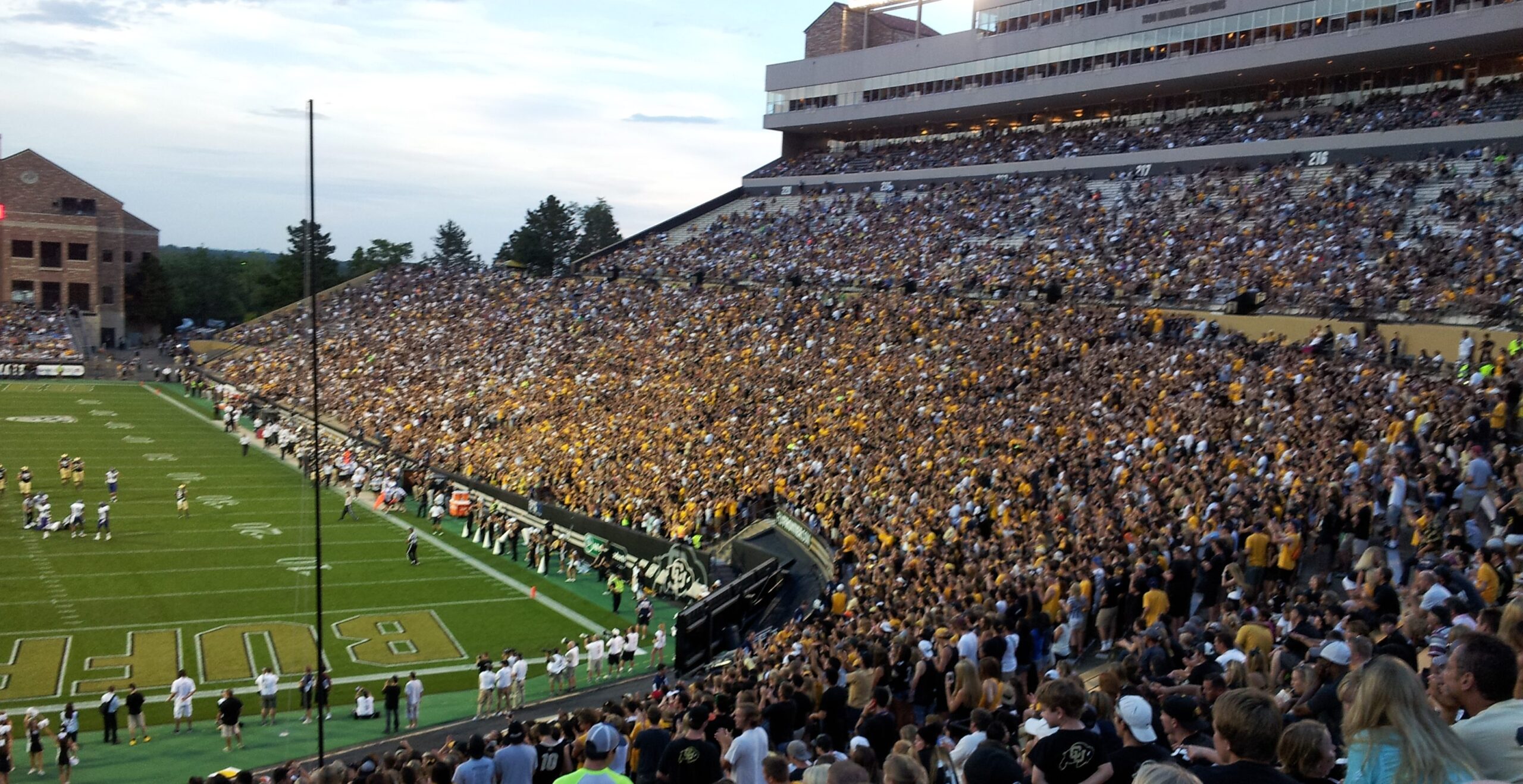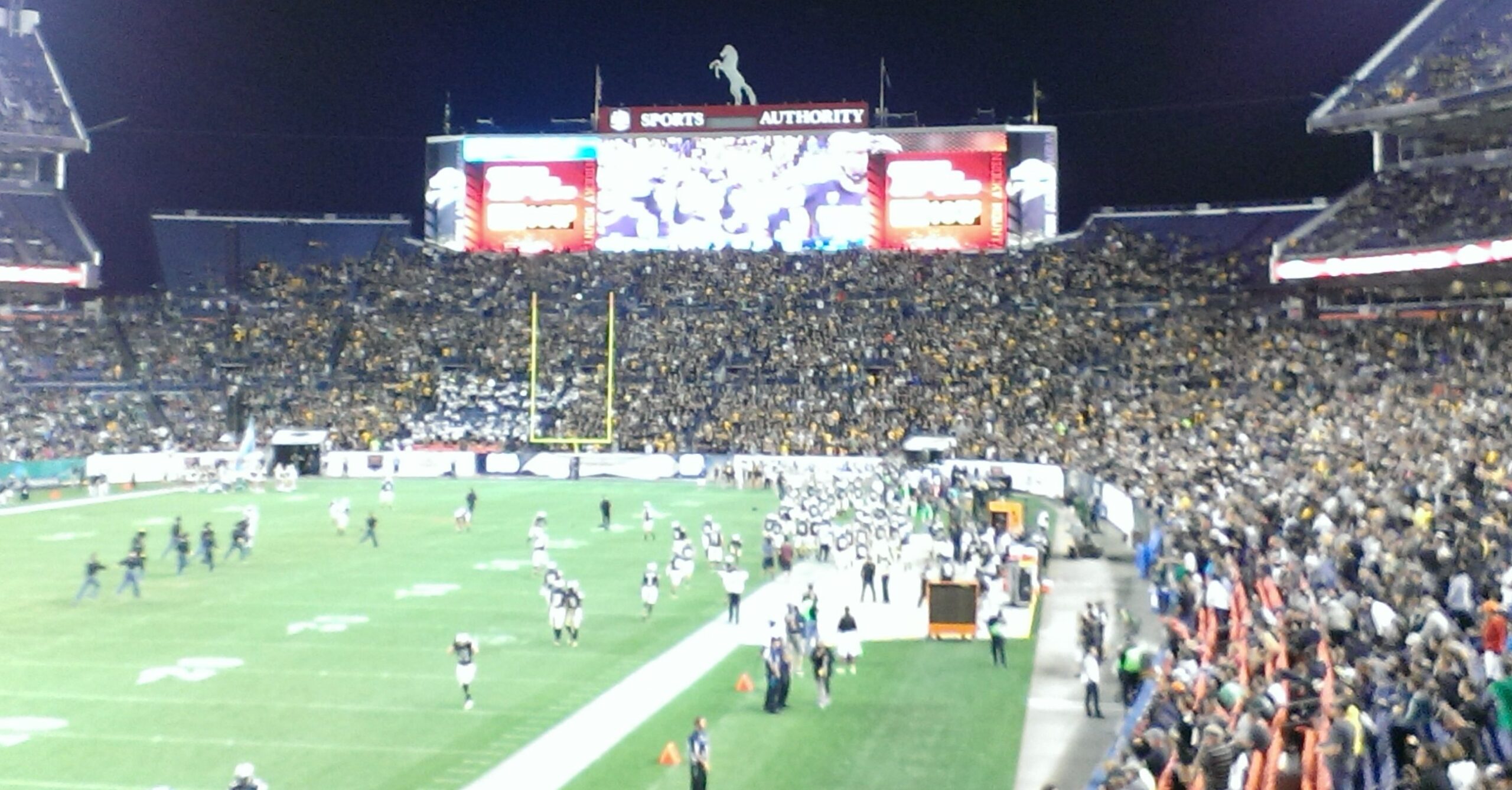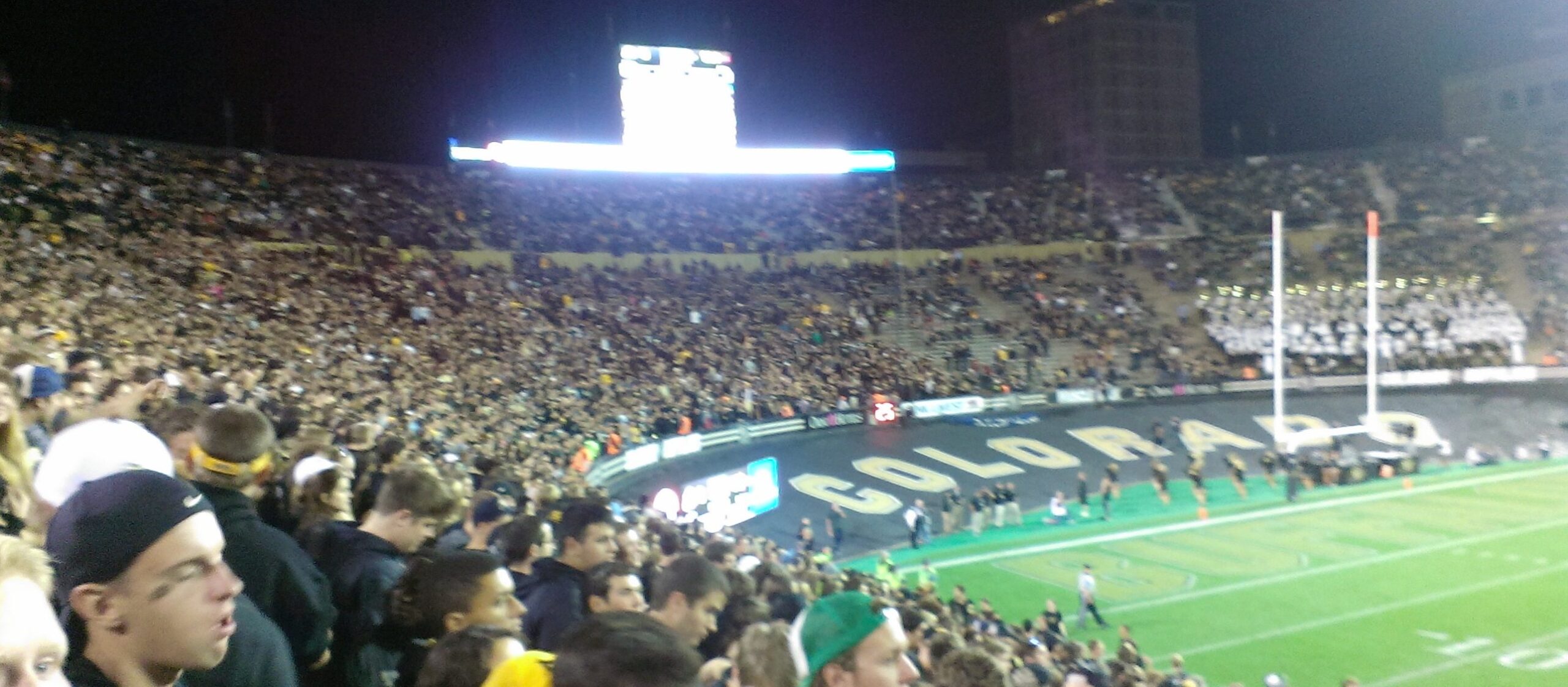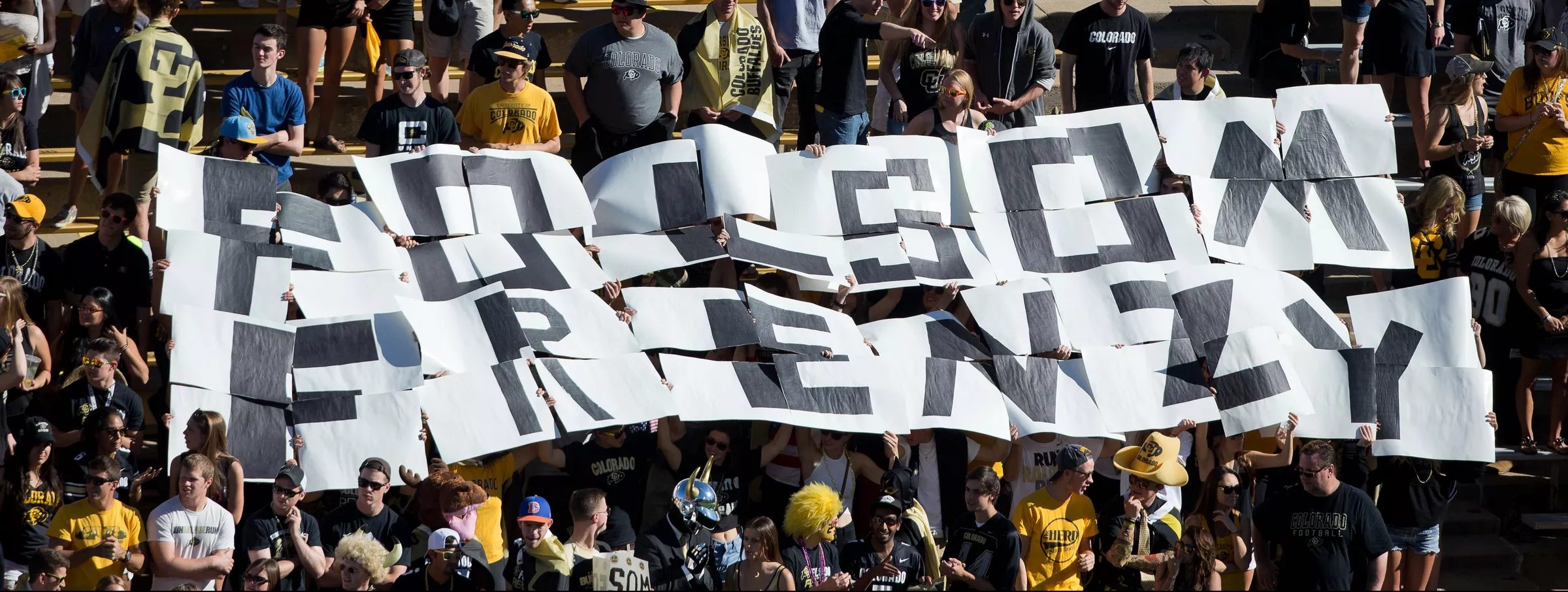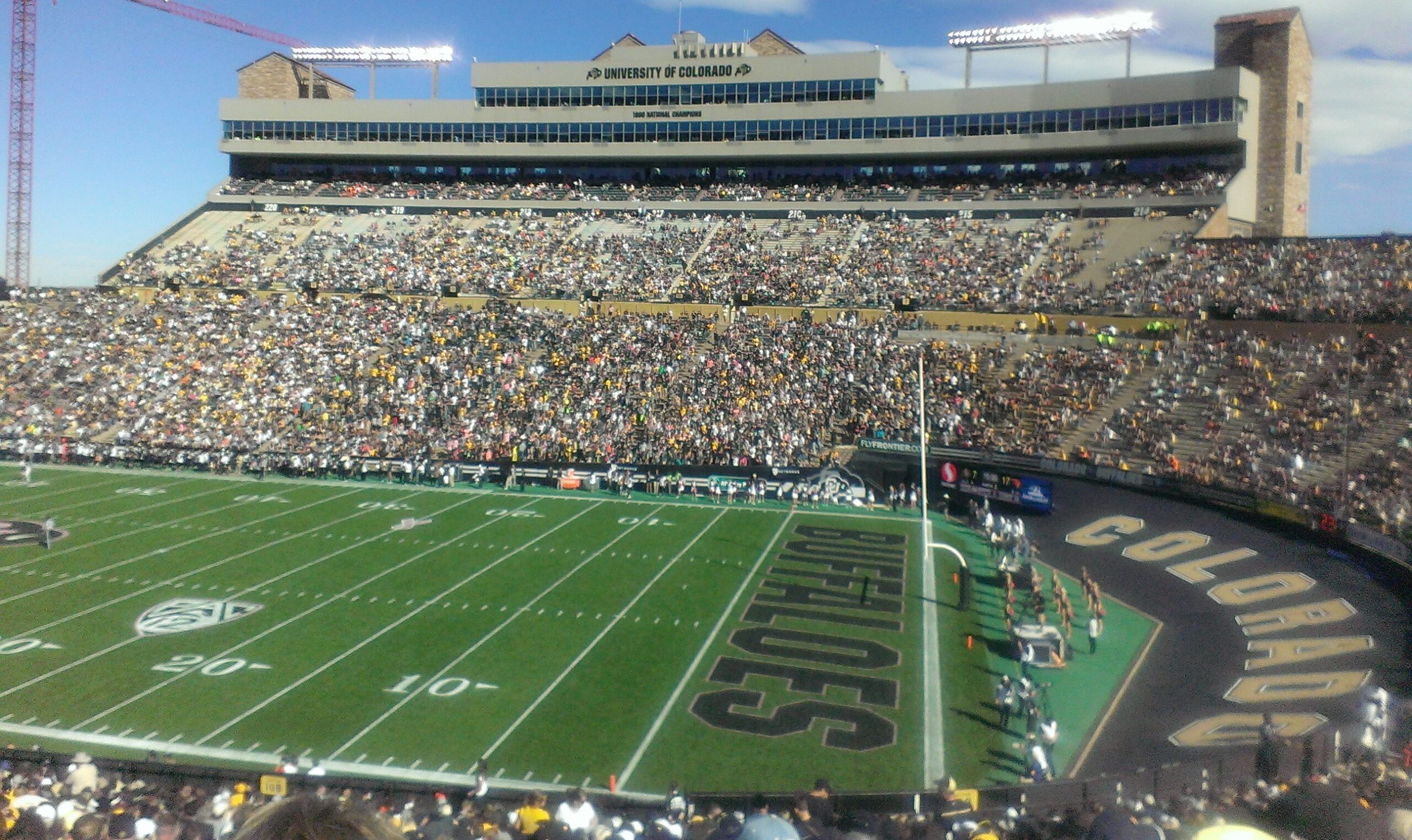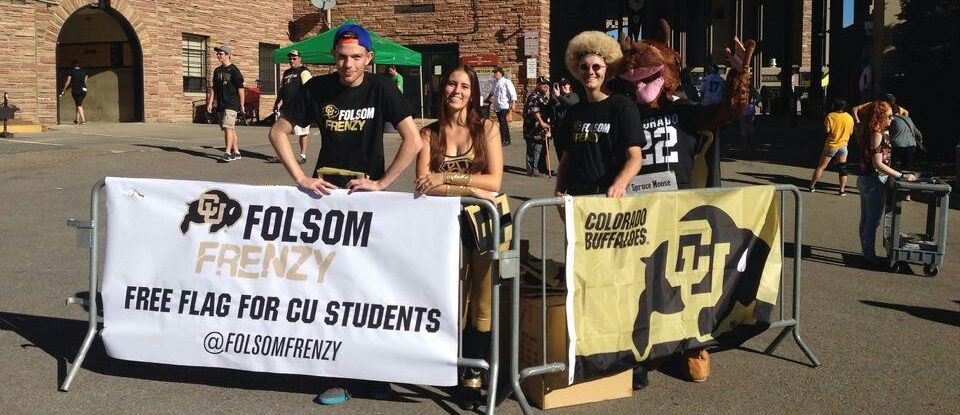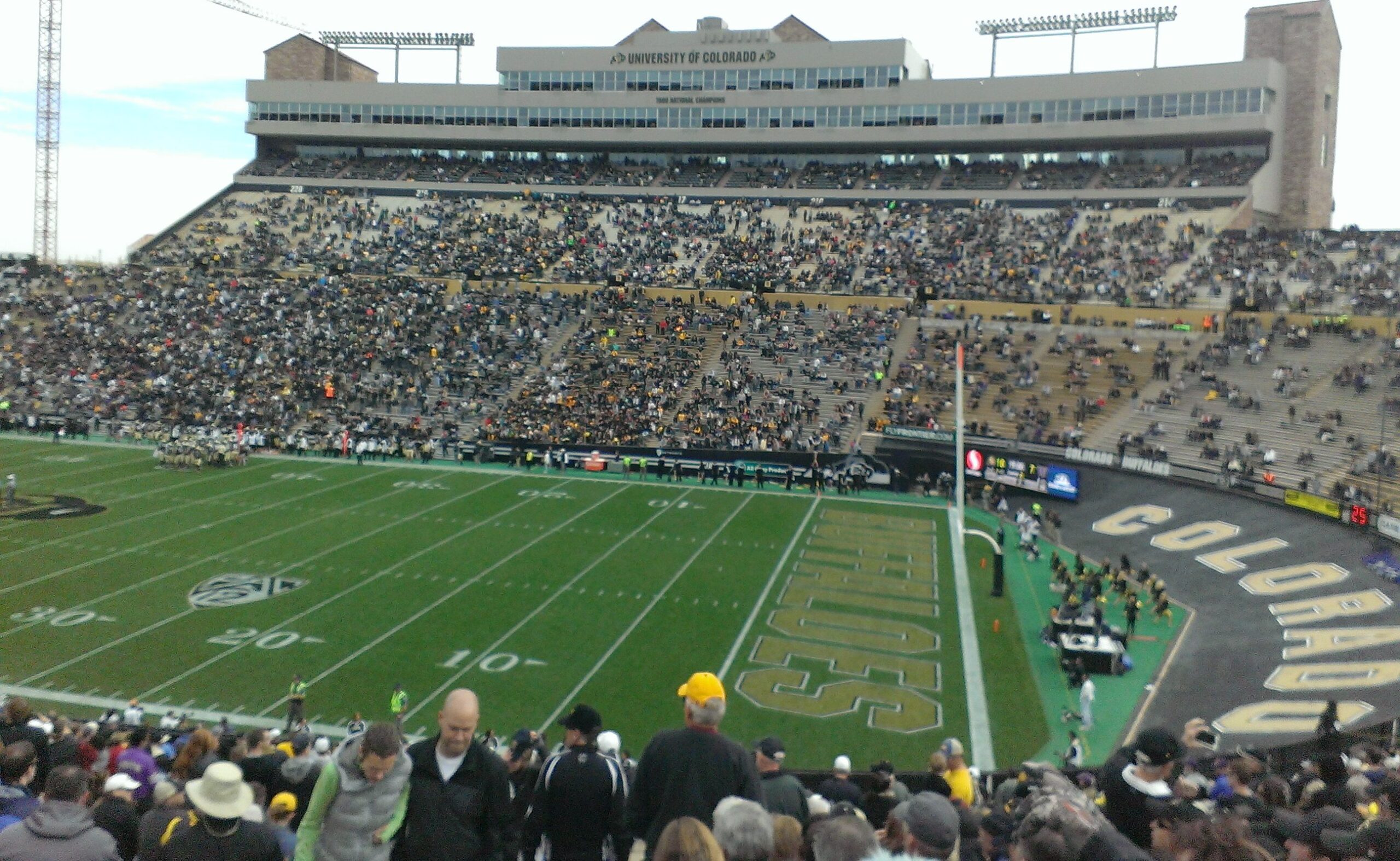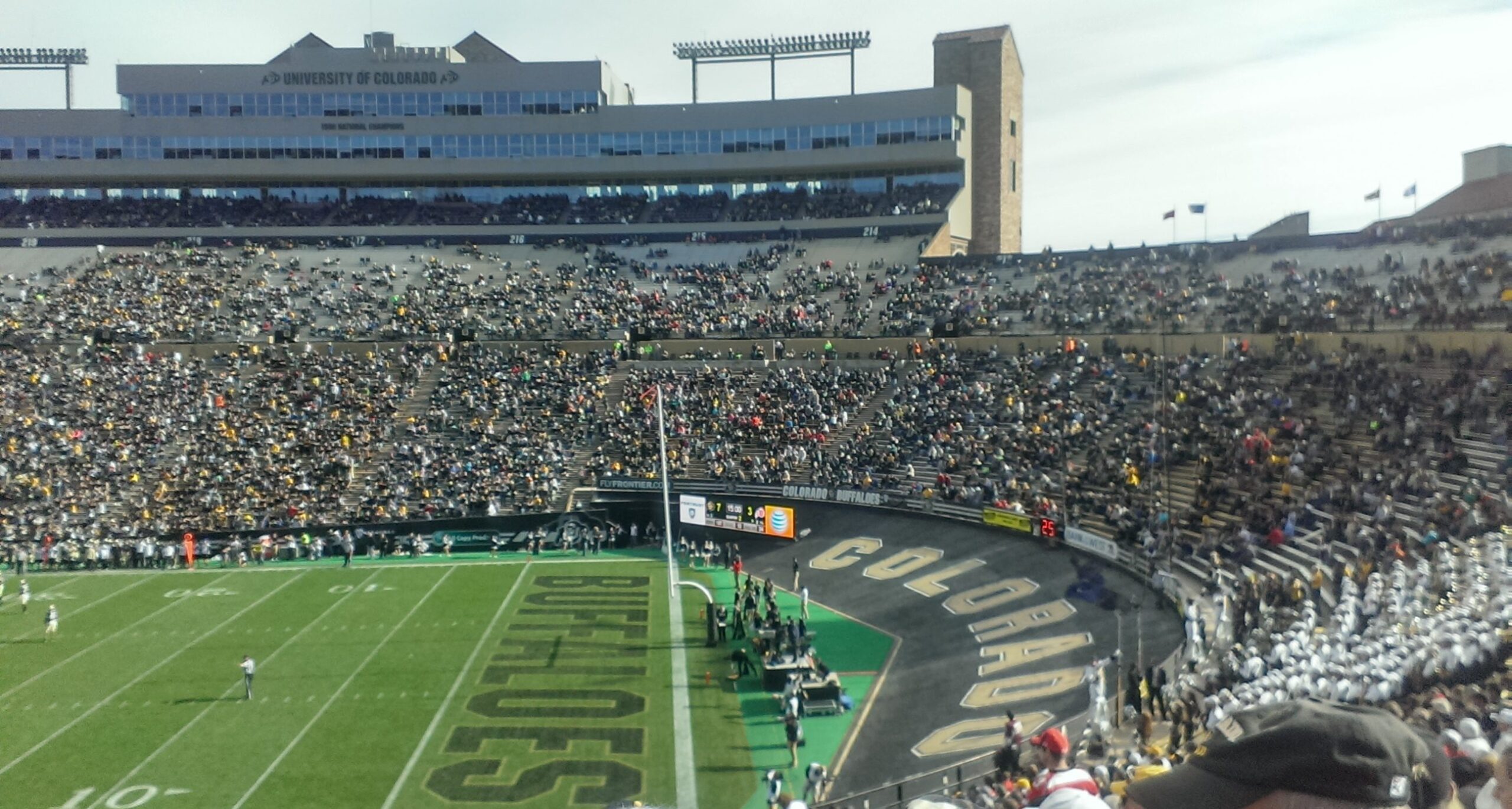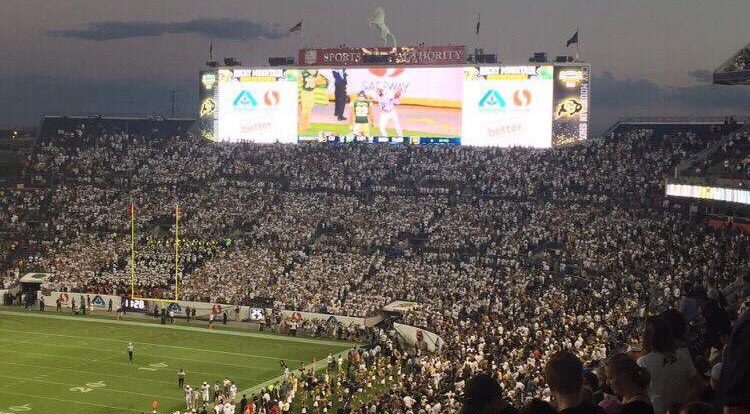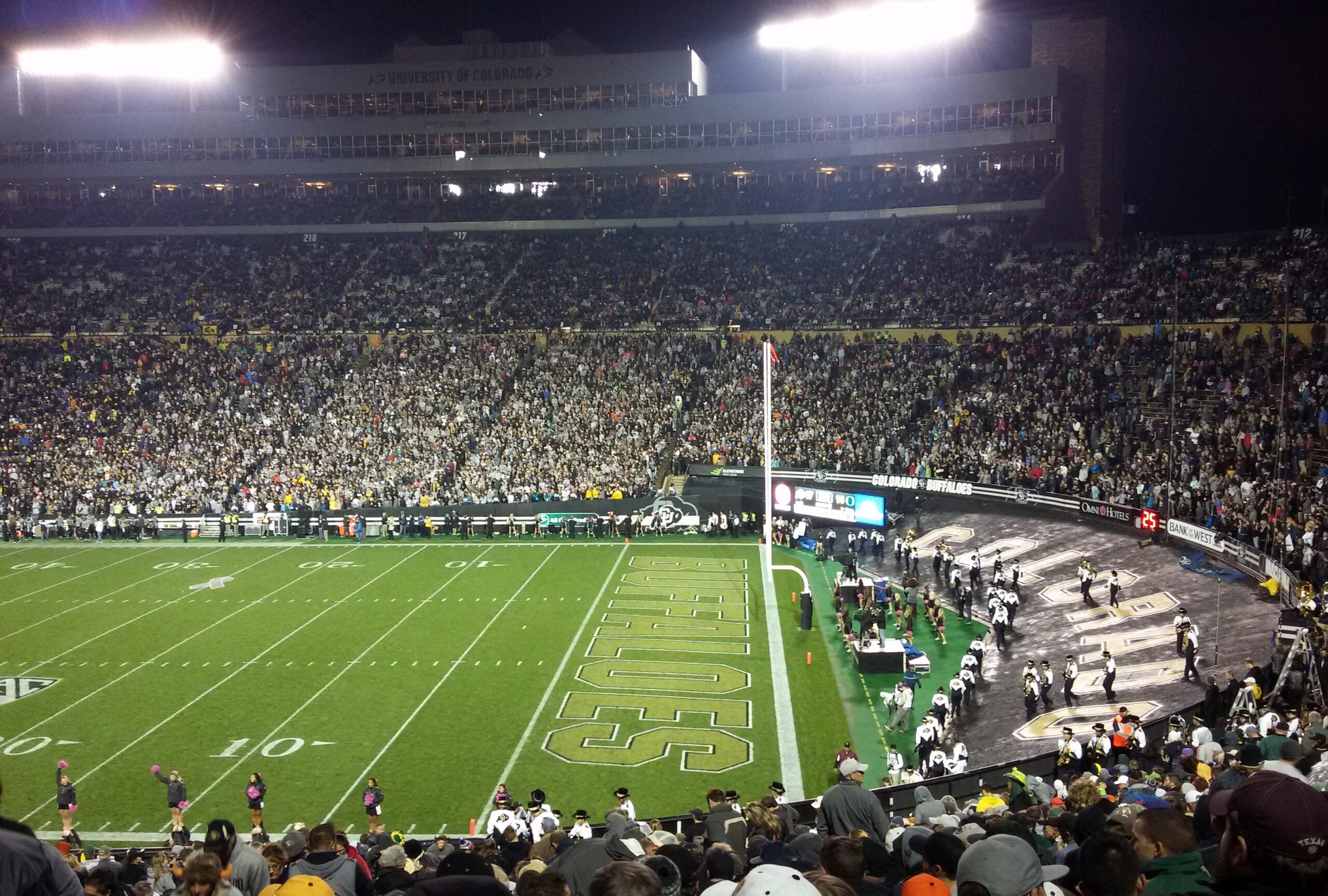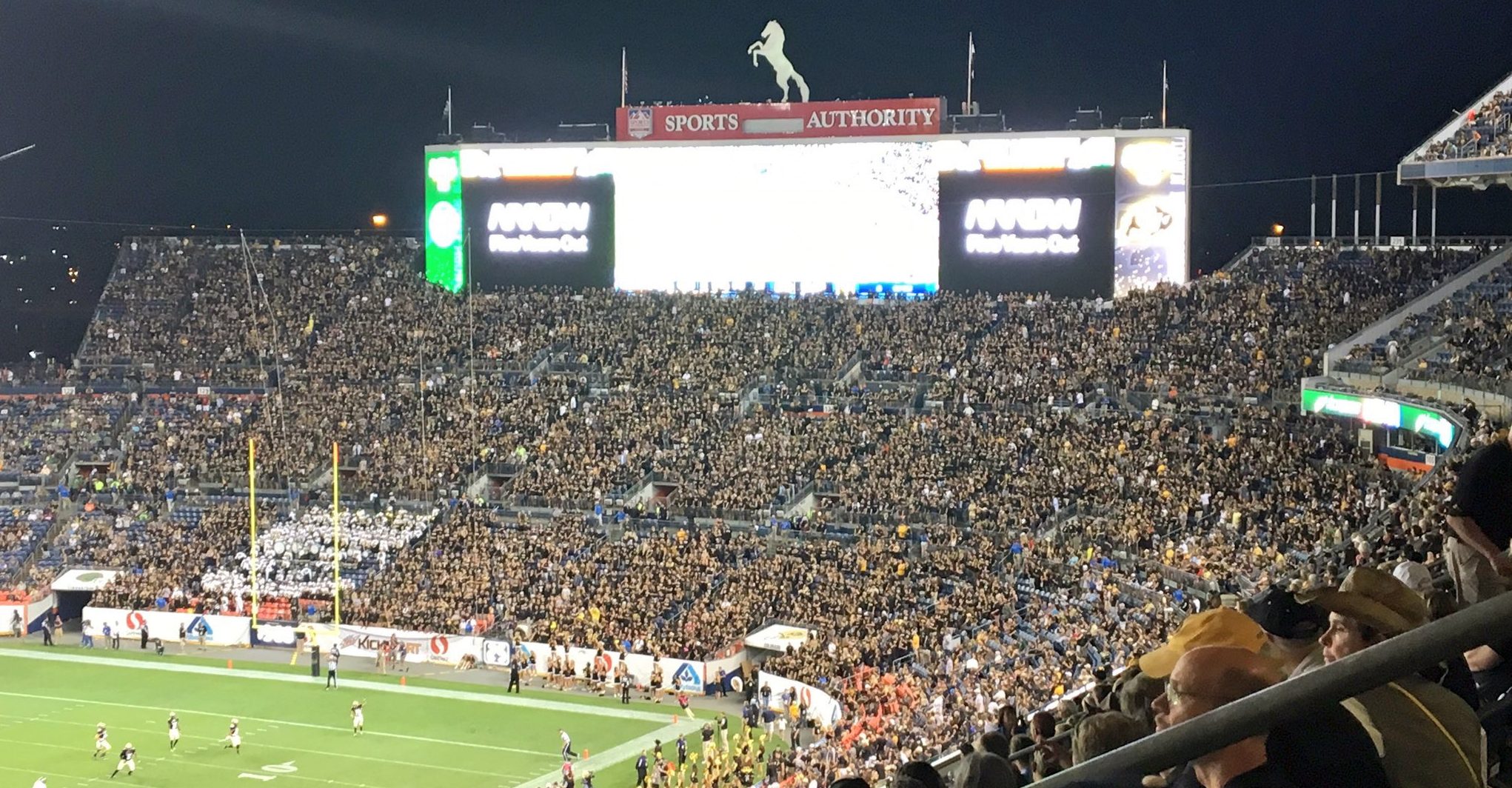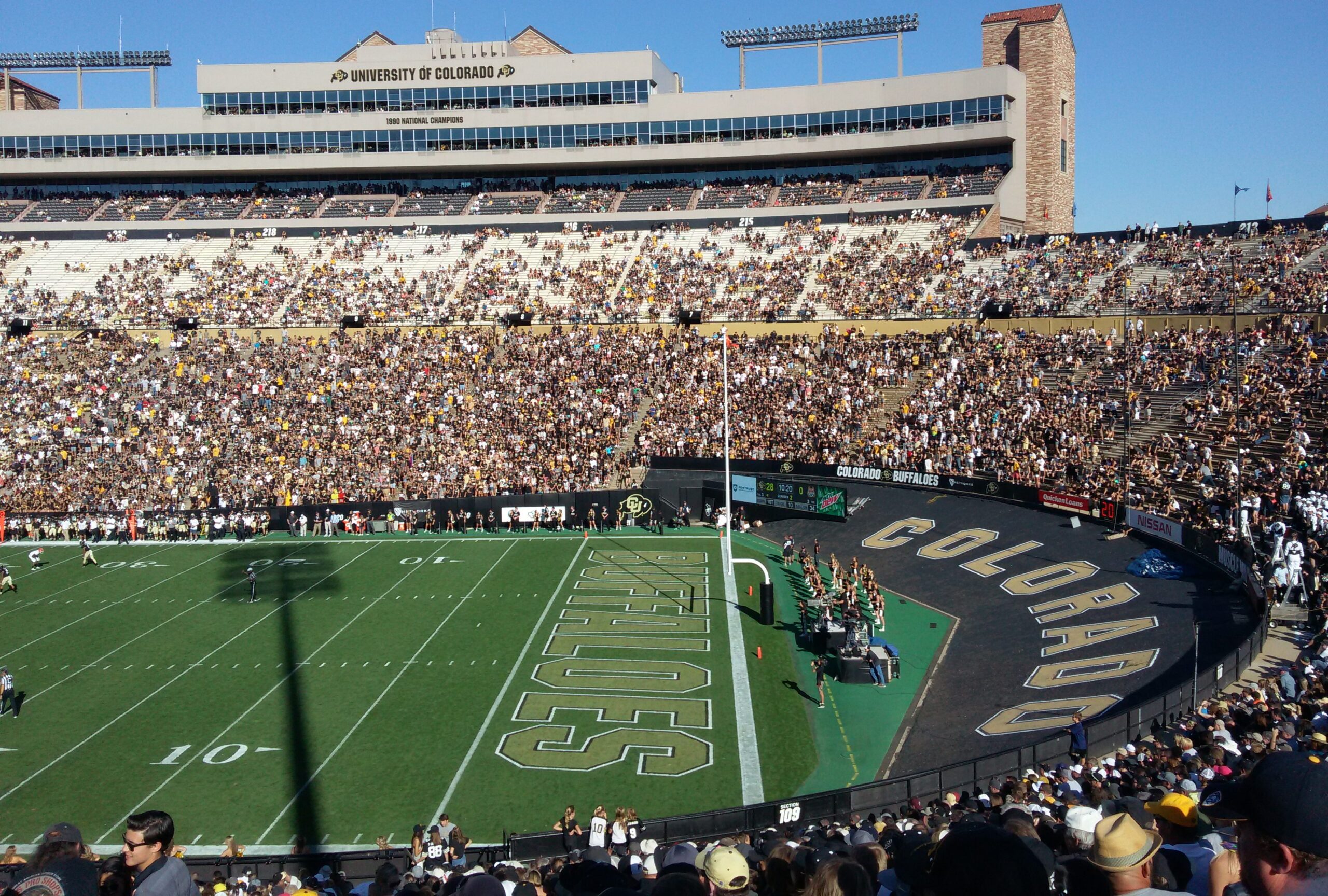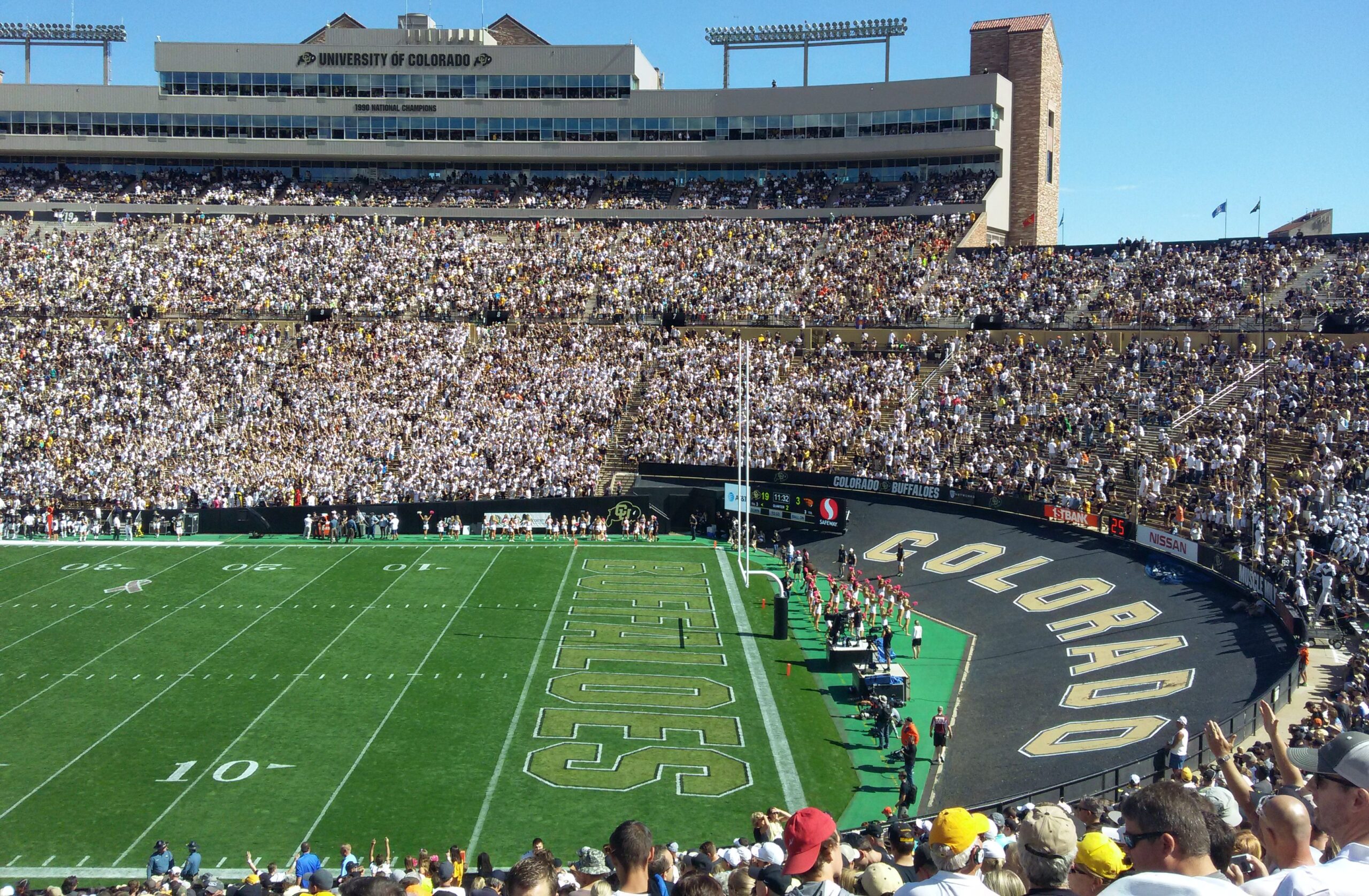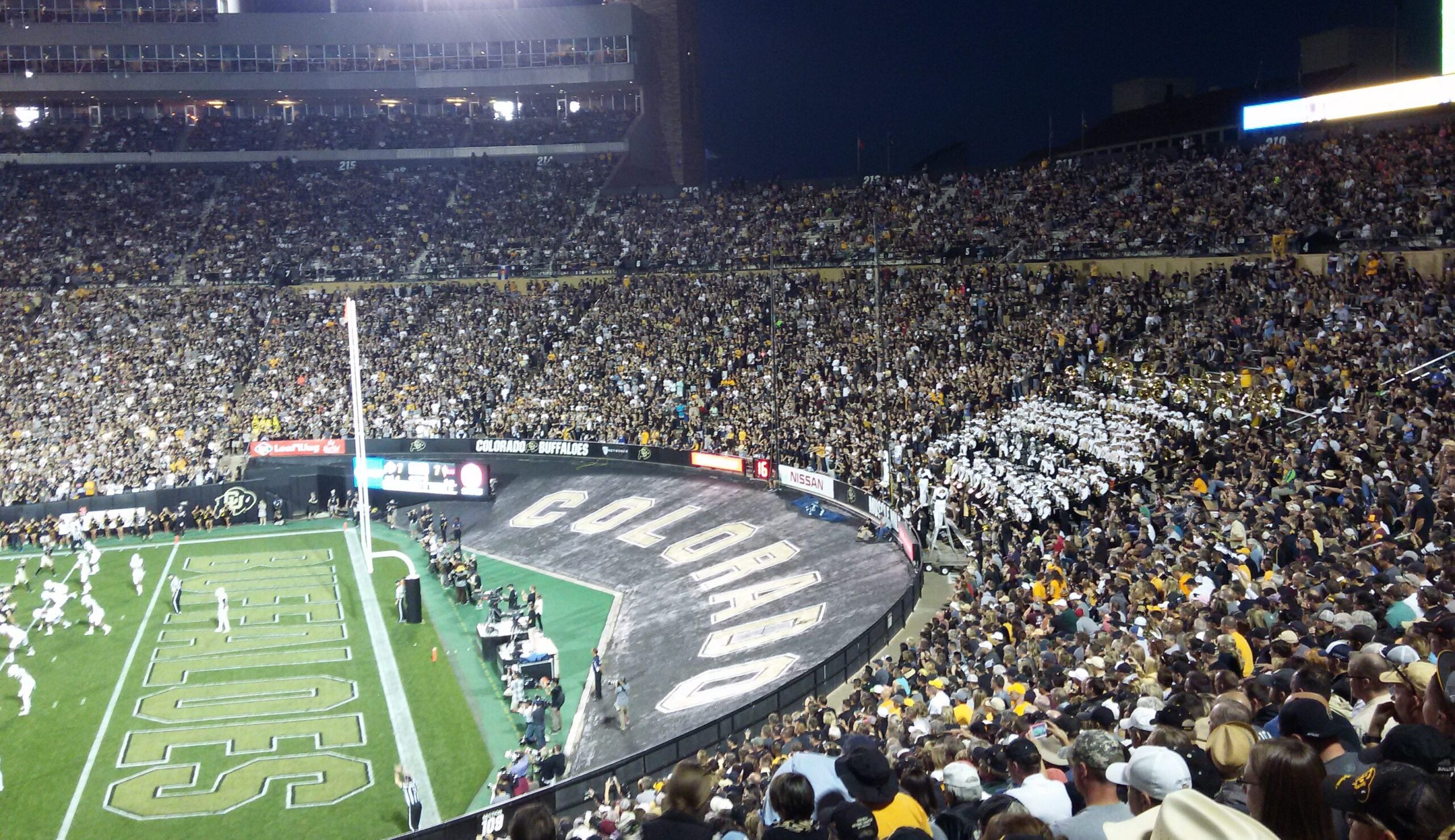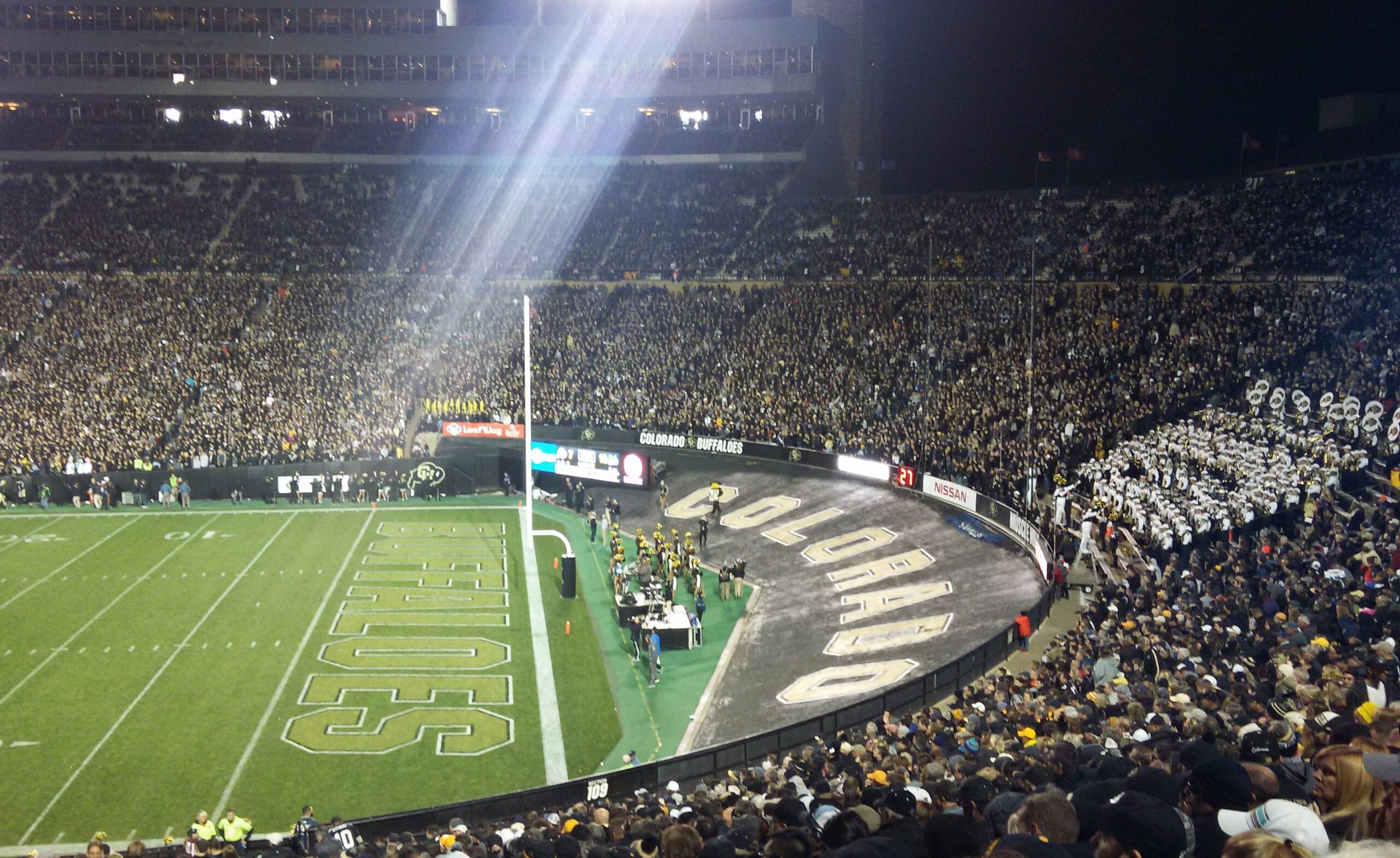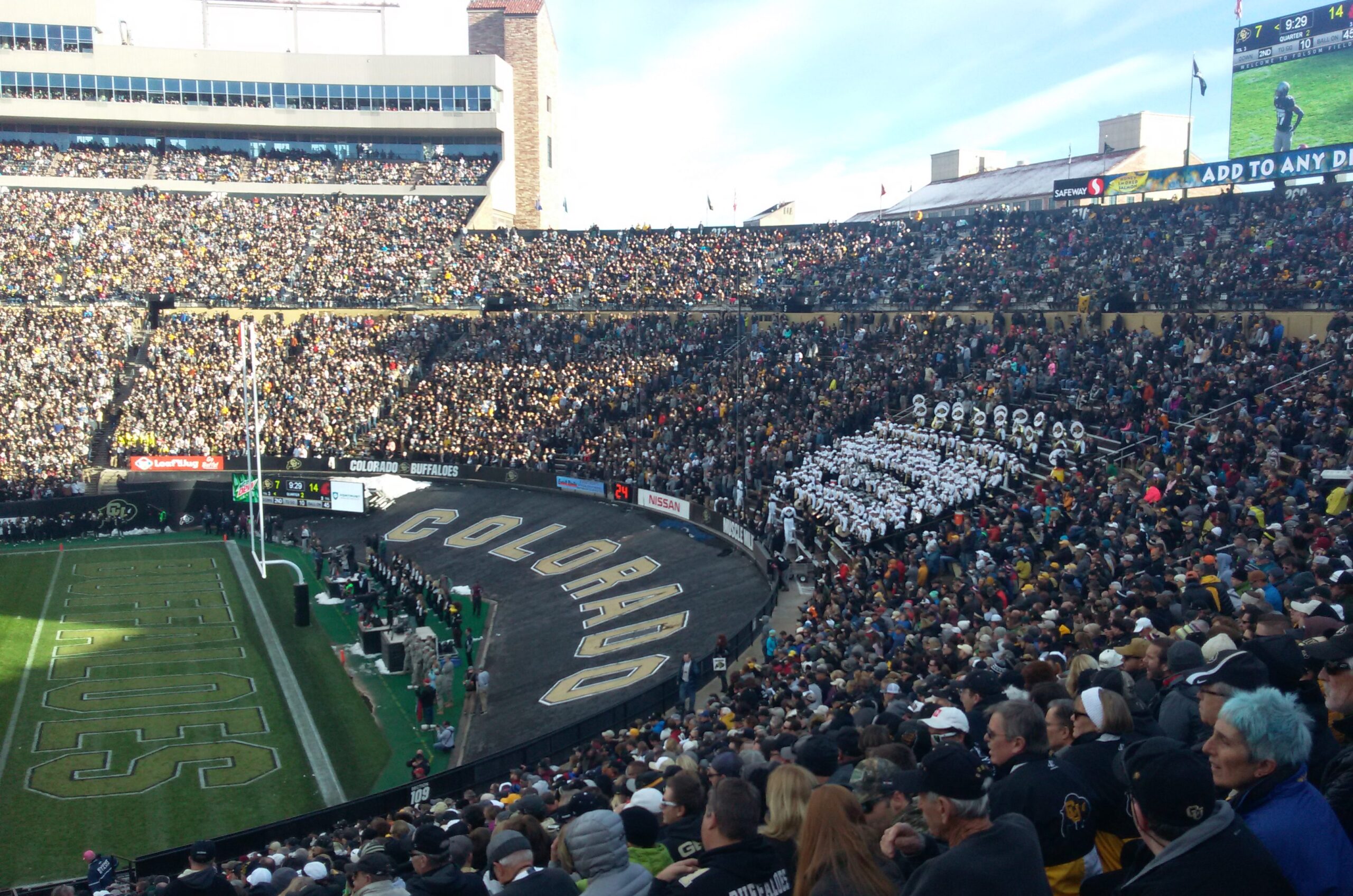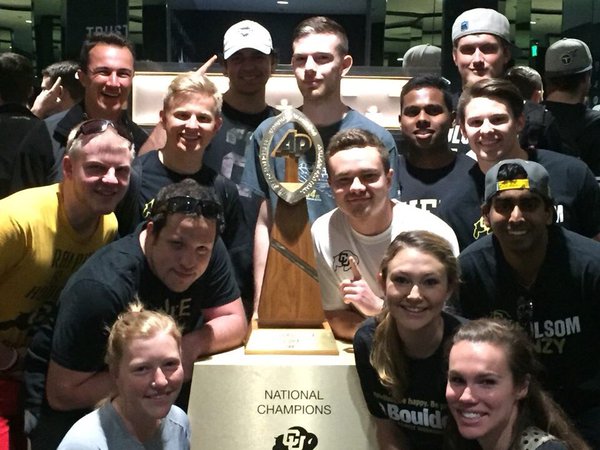© 2025 ALLCITY Network Inc.
All rights reserved.

Prologue
Last Friday night, more than 10,000 University of Colorado students packed the south stands at Mile High Stadium to watch their team win the Rocky Mountain Showdown for the third consecutive year. CU nearly ran out of student sports passes before the game, and students lined up around the block to get them on game day. These scenes may sound familiar if you’re a longtime fan of Colorado Football, but to me, they’re strange and beautiful sights that I still haven’t gotten used to. It wasn’t very long ago that I would have found such things impossible to imagine, and I’m writing this article because I think it’s important to remember where we were just a few short years ago in order to appreciate and treasure where we are now.
Feel free to read this article in sections. It’s quite long. If you’re ready, let’s take a journey.
Part One (to 2013)
Some of you already know that I used to be one of the leaders of the CU football student section. The organization is currently known as C-Unit Football, but it began life in 2014 as Folsom Frenzy. Before that, there was no organization for students at football games. The original C-Unit was created in 2004 exclusively as a basketball organization. It established traditions and loyalty that hadn’t existed before among the relatively small numbers of students who attended basketball games, and when the basketball program exploded in popularity under Tad Boyle, the C-Unit turned into one of the best student sections in the country.
For decades, there was no need for a comparable organization for football. Going to football games was just something you did as a CU student. It virtually sold itself. You even had to pay extra if you wanted to attend the Rocky Mountain Showdown in Denver. Every CU fan can instantly picture in their mind the image of the student section at Folsom Field adorned all in yellow-gold, stretching from the 35-yard line all the way to the back of the end zone. Then there were the famous blackout games against Georgia and West Virginia, where the entire stadium was cloaked in black, and the student section ended the night with a field rush.
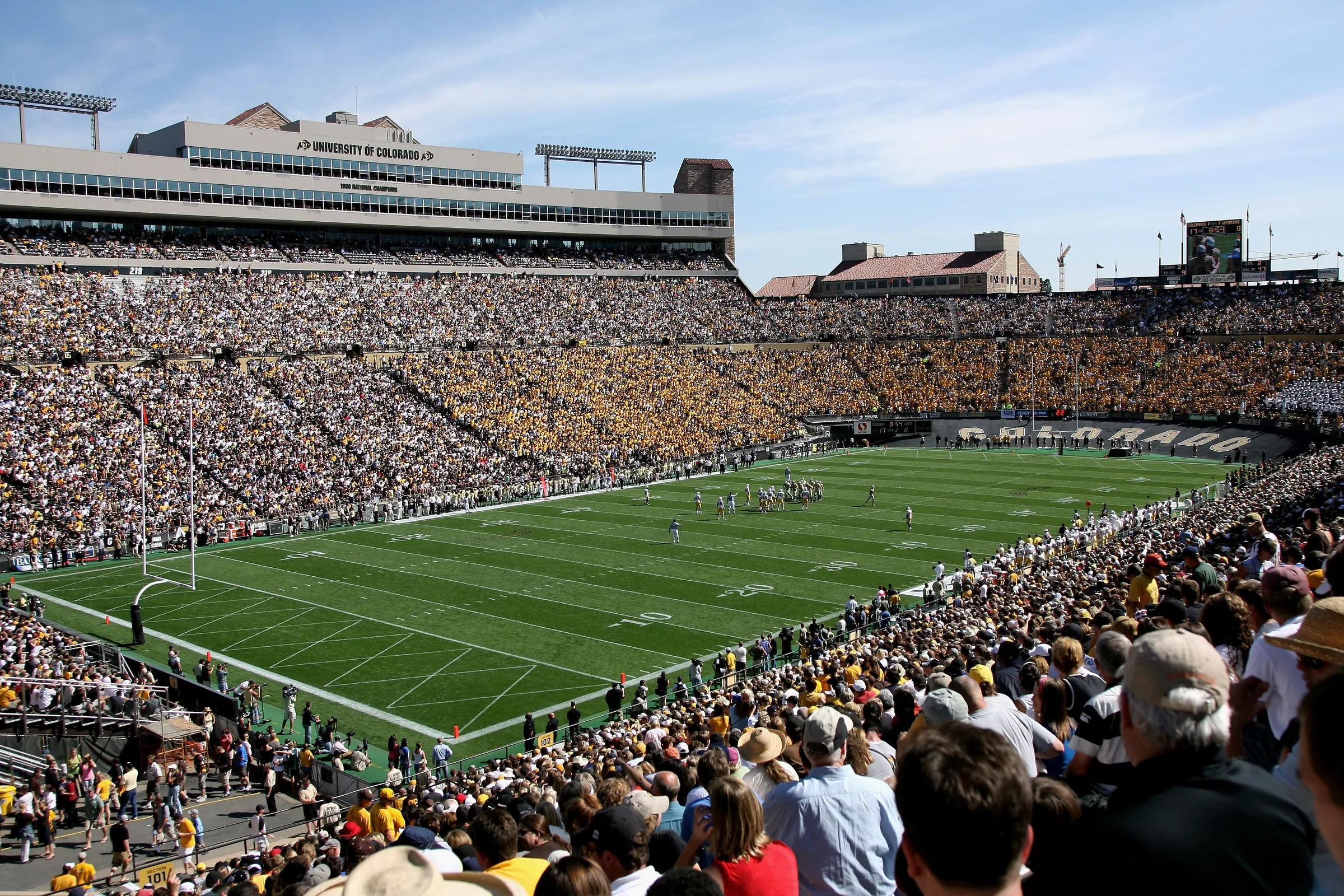
Despite only making one bowl game in the Dan Hawkins era, the Buffs were still very competitive at home; routinely knocking off tough competition. In 2011, however, that began to change. The team went just 1-4 at Folsom, including 45-2 and 42-17 losses to Oregon and USC. A victory over a 4-8 Arizona team on Senior Day was cause for one of the most questionable field rushes at a program that has been full of them, and it would turn out to be the last one for half a decade.
It’s impossible to understate how bad the 2012 Colorado Buffaloes were. They were literally the worst team in the entire country, and they would have gone 0-12 were it not for a miraculous comeback against Washington State. While they avoided that dubious mark, they did go 0-6 at Folsom Field for the first time ever, and every single loss was demoralizing. First, they lost to FCS Sacramento State. Then they lost their first four home conference games by margins of 28, 34, 48 and 35 points. In the regular season finale, they tied Utah in the fourth quarter on a kick return touchdown, only to give the lead back on the ensuing kickoff and lose 42-35.
If you’re reading this article, you probably know all of this already. So why am I repeating it?
Imagine you were a freshman student in 2012. Why would you ever want to pay to see a CU football game again? Also, imagine being an incoming freshman in 2013 and being told by all the students, whose only memories were of 2010, 2011 and 2012, that the basketball team was the only thing on campus worth paying attention to.
When I was a freshman, CU offered two sports passes. One cost $140 and only included football games. The other cost $175 and included both the football and basketball games. Perhaps it’s hyperbolic to think this, but I honestly felt at the time that a $100 basketball-only option would have outsold them both if it had been offered.
All that said, it was still a festive student section the first two games of the 2013 season, as the Buffs defeated CSU at Mile High and survived a scare from FCS Central Arkansas at Folsom before the smallest overall crowd since 1988. Little did I know then that, at least by official numbers, it would be the largest student section at Folsom until my senior year.
After the Fresno State game was canceled due to the 2013 floods, the Buffs’ next opponent was No. 2-ranked Oregon. One of my lowest moments as a student was hearing someone behind me in the student section say that they were only there to see the Ducks. The student section for this game was large, but by the second half, the entire stadium was virtually empty after Oregon had taken a commanding 43-16 halftime lead. I confess that I left at halftime and walked back to my dorm with my head down.
During these games, I noticed that there weren’t quite as many yellow-gold shirts in the student section as I had expected. A trip to the team store revealed that they were no longer available for purchase. A decision was made that yellow-gold was no longer an official CU color. Incoming freshmen used to be given yellow-gold shirts for convocation. For my freshman year, we were given either grey, black or sickly-looking pale “gold” shirts, depending on the college we were in. At the same time, it was rapidly declining in numbers, the football student section also lost its signature look, although the full effects of the decision to remove yellow-gold weren’t seen until the following season.
The next home game was a makeup game against Charleston Southern, and it was unquestionably the smallest crowd Folsom Field had seen in a very long time. The student section was also pitiful, if not quite as bad as the last two from 2012. There was an all-out marketing blitz the following week to try and get students to come to the Arizona game, which was the blackout game that season. A decent student section showed up, but it was smaller than the first two games of the season and far less than any blackout game in memory. Again, most had left by the end of a 44-20 loss. Another low moment in my fandom came when someone in the Ralphie Report comments tried to argue that the Buffs hadn’t been blown out in the game, which was indeed close at halftime. I guess if one was basing it on 2012 standards, it was a nail-biter.
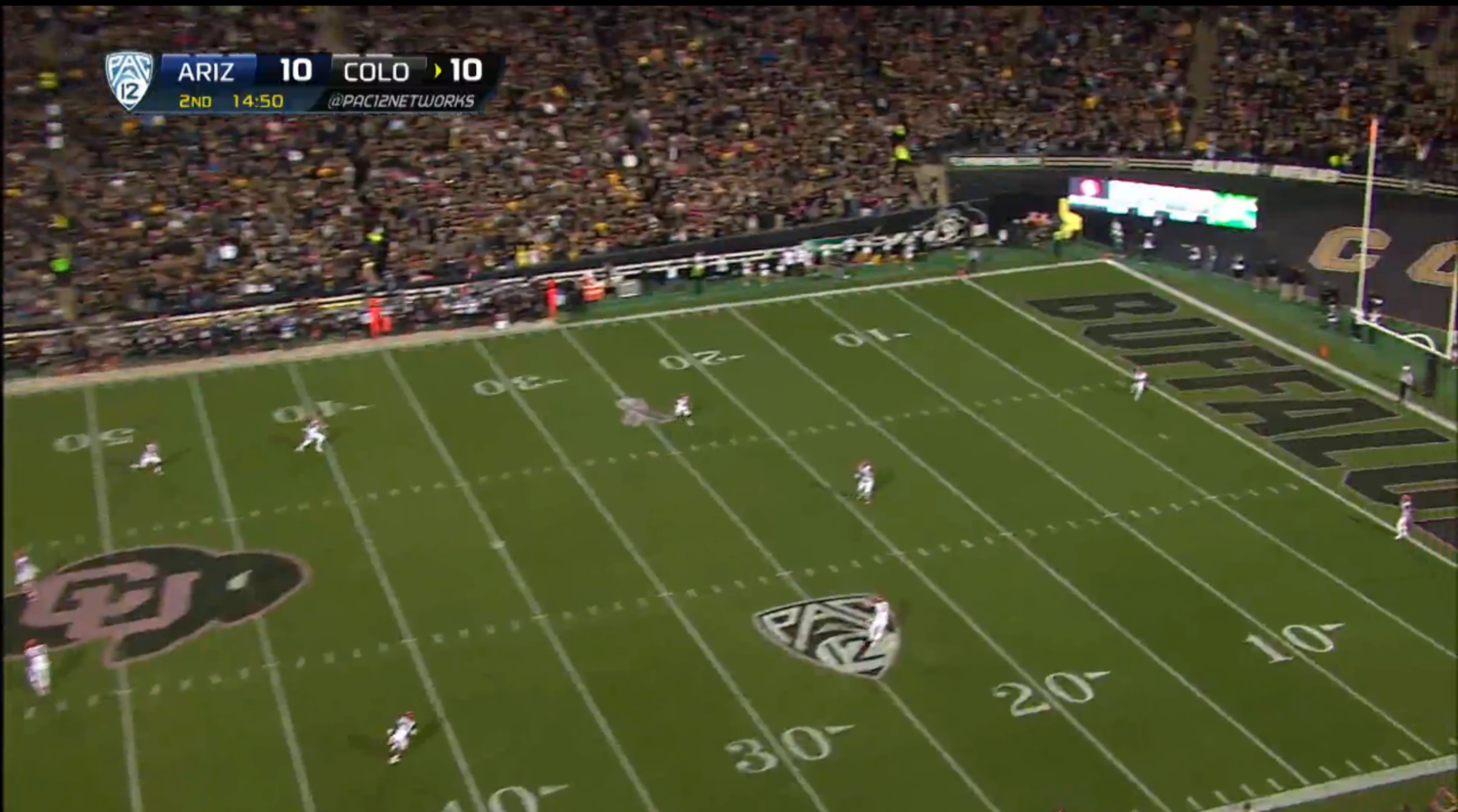

The only conference win I saw in my first three years as a CU student came against Cal on November 16. By that point, the Buffs were 3-6 and their season was basically over. The student section was as small as the Charleston Southern game, and on a bitterly-cold and windy night, they couldn’t be persuaded to stay until the end of a 41-24 CU victory. I remember seeing a photo of the team singing the fight song after the game in front of the remaining students, who they probably outnumbered, and feeling sorry for them.
The final game of the season was an 8:30 kick against USC on the first Saturday of Thanksgiving break. Almost no one showed up. Like the last two games of 2012, student attendance fell below four digits. And as the wind swept through a virtually empty student section, I again left at halftime with the Buffs trailing 33-0. Two weeks later, nearly three times as many students would see the basketball team upset No. 6 Kansas. People lined up hours beforehand in 10-degree weather to get in the door. CU was unquestionably a basketball school.
By this point, it was clear that football needed the same kind of student organization basketball already had. I wanted to do something about it, but I had no idea how to get one started. Fortunately, other people were already working on it.
Part Two (2014)
During the first week of classes my sophomore year, I got an email asking me to attend an inaugural meeting for an unnamed football student section group. I wasn’t able to go to the first meeting, but I told them I was interested and they told me when the second meeting was.
In between me receiving the email and the first meeting I attended, two football games happened: the Rocky Mountain Showdown against CSU, and the first home game against Arizona State, which was also that year’s blackout game. It turned out that they would be the two largest student sections of the year. At halftime of the Rocky Mountain showdown, I decided to walk all the way to the other side of Mile High and take a picture of the student section. This is what I saw.
To tell you the truth, I was somewhat disappointed. I had expected to see it go all the way to the top. I also realized for the first time the full extent of taking the yellow-gold shirts away. This was the first in a long series of student section pictures I took that will help me tell the rest of this story.
The next game, against No. 16 ASU, had a very full student section; probably the biggest I saw in my first three years at CU. However, the number of student scans was far from the largest. This puzzled me when I first saw the data last year, but I don’t think it’s a mistake. I think many students bought tickets on the secondary market for that game and the Rocky Mountain Showdown without wanting to pay for the entire sports pass. That’s not a great endorsement of a football program. Neither is the fact that, once ASU staked themselves to a 38-17 lead in the second half, the huge student section dwindled down to almost nothing, prompting someone to remark “if CU upsets ASU and no one is there to see it, did it really happen?”
The game finished 38-24, and it wasn’t really “over” until a Liufau interception with a little over four minutes remaining. All anyone could talk about at the first meeting I attended the following week was how exciting it was that CU didn’t get totally destroyed by a good opponent.
Over the course of our first few meetings, we agreed on the name “Folsom Frenzy” and, with the help of CU marketing, came up with a logo. We made Twitter and Facebook accounts. It was a start. We had big ideas and no money.
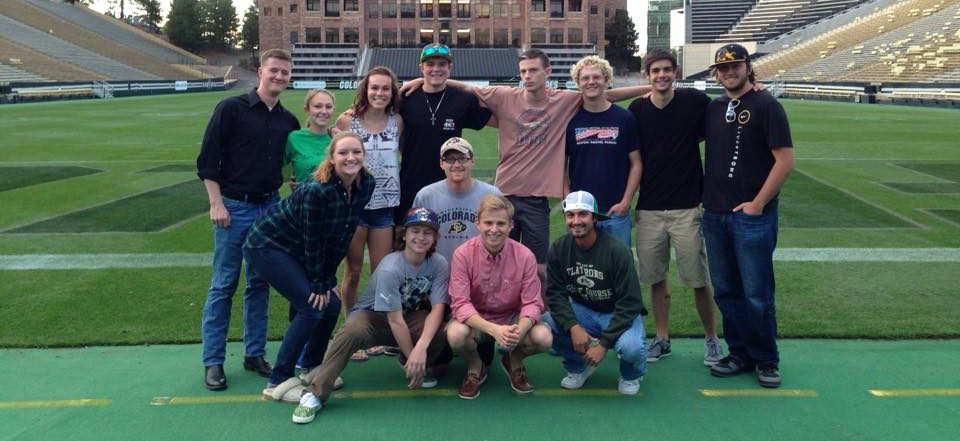
There wasn’t enough time to plan anything for the Hawaii game, which would turn out to be CU’s second and final victory of the season. The next home game was against Oregon State, and we decided that our first major public act would be a “card stunt.” We made 48 cards that spelled out “FOLSOM FRENZY,” and decided to hold them up right before halftime. It just so happened that the Buffs were leading 21-20 at the half, and the crowd was in a good mood, so when our hastily-made sign went up on the jumbotron, it got a cheer. I was so proud.
The Oregon State game was also the first time I made the trek over to the other side of Folsom to take a picture of the student section. From this point forward, I took it at or near the beginning of the second quarter for every game, so I would have a way to track our progress (or possible lack thereof). Again, I wasn’t thrilled with what I saw. From the front row on the 25-yard line, it was easy to feel like there were a lot of students there, even though I could see the empty end zone. But from this high vantage point, it was obvious that the first two sections weren’t even full all the way to the top.
A fair number of students, at least compared to years past, stayed until the end and the stadium actually got loud when the Buffs, trailing by five, forced the Beavers to punt with two minutes left. Of course, the game ended in disappointment.
The next game was against UCLA, and a very generous sponsor gave Folsom Frenzy 3,000 CU flags to give out to students. It remains the coolest giveaway I’ve ever seen at any event. We thought we were big time now. We couldn’t even give them all away. The size of the student section that day was nearly identical to the Oregon State game three weeks prior. Still, the giveaway was great publicity for us and helped us make a name for ourselves.
The UCLA game was the biggest heartbreak in a season that was full of them, but it did have a few silver linings. Despite the Buffs trailing 31-14 at the start of the fourth quarter, there were far more students left at the end of regulation than there had been at the ASU game. The Cal and Oregon State games had convinced people that the Buffs could hang with conference competition again. That said, the student section was still relatively small at the start of overtime and the rest of the stadium wasn’t close to sold out either, but this enabled us to do something pretty cool. The first overtime was at the north end of the field, so the student section migrated en masse over to that side – filling in any gaps and standing in the aisles. I remember thinking how cool it would be to storm the field from the opposite 20-yard line. It didn’t happen. After that game, I was about as dejected as I’ve ever been after a sporting event. I thought it was going to be the breakthrough for the program, with all the hype and attendance boosts that go along with that. I would have to wait nearly two years for that day.
The next game was a week later against Washington. Kickoff was at 11 am on the morning after Halloween. The picture wasn’t pretty. This day was also the first (and it turned out to be the last) Folsom Frenzy t-shirt giveaway. We only had 500, and I don’t think we got rid of all of them before kickoff. In the following years, I would always smile when I saw someone wearing one, because I knew they were enough of a fan to have been at that miserable Washington game.
During the first quarter, the Folsom Frenzy Twitter account was mentioned by someone on Twitter asking if we had “forgotten to set our alarm clocks.” My first thought was “Hey, at least they know we exist!”
As mad as I was at the student body for not caring about the football team, I couldn’t think of a single good reason for them to come to games. The last game of the season was against Utah over Thanksgiving break, and no one showed up. CU gave away thousands of tickets to season ticket holders just to try to make the crowd look somewhat respectable. Most of the people you see in the student section weren’t actually students.
It was another awful loss, but this time I was more numb than angry; even though I had to change my return flight from my Thanksgiving vacation in order to accommodate another onerous 11 am kick.
Without question, 2014 was the low point for the support of the Colorado football program. After 24 consecutive seasons (1989-2012) without a paid attendance below 40,000, 2014 didn’t see a single paid number above 40,000. Keep in mind that the paid attendance numbers always reflect a full student section, so actual crowds for most games were below 30,000. If you need proof that actual student turnout doesn’t impact the announced attendance number, consider that the Utah game had a higher paid attendance than the ASU game.
There was nowhere to go but up.
Part Three (2015)
Going into 2015, Folsom Frenzy had bigger goals, and the marketing department had even less money than before. The poor attendance of the previous season hurt, and an investment in a student rewards program that looked good on paper but turned out to be flawed in its one year of implementation didn’t help either. The result was that there was nothing as cool as flags or t-shirts to be given away. We had to come up with new ideas.
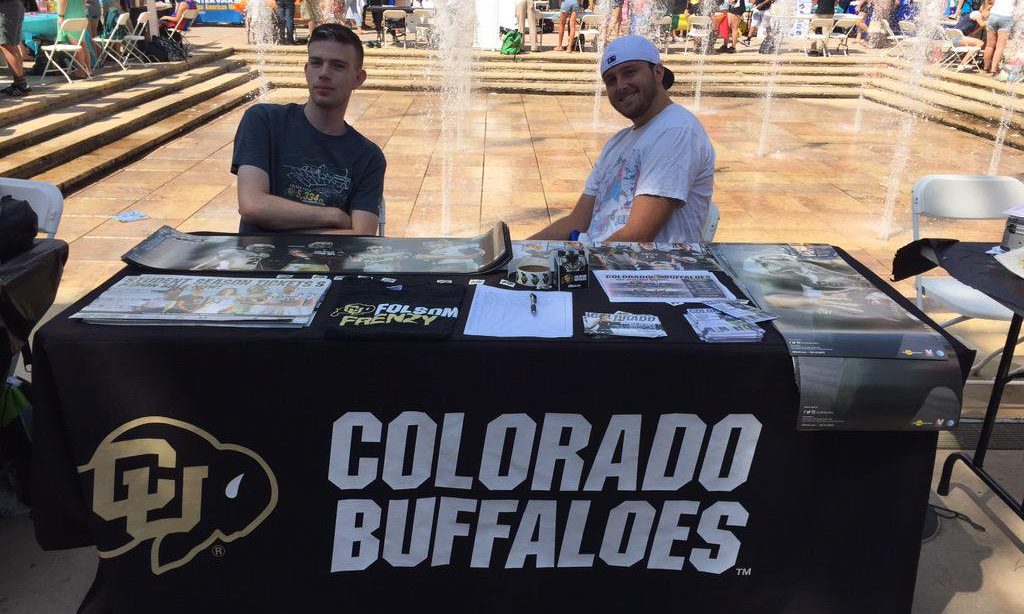
Instead of starting off the season like normal, the Rocky Mountain Showdown was the third game on the schedule, and the home opener was a week before it. This meant that sales of the $140/175 sports pass were lagging, as people usually bought it before the week of the CSU game. Each year, a new class of freshmen (always the largest group at any college sporting event) gets to make up their minds about whether or not a team is worth watching. This year, their first taste of CU football was a loss against Hawaii that ended at 3 am Mountain Time. Things didn’t look good.
Folsom Frenzy, like many others in the CU community, went into the season thinking it was going to be the year that the team finally made it to a bowl game. We even picked out a hashtag, #RalphieRevolution, in anticipation of the program’s, uh, rise. The week before the season began, I went out in the dead of night with two other members and shot a promotional video that, if I’m being honest, was pretty cool considering we had no money to make it.
However, before I was even finished editing it, the team was already 0-1. I even had to work in the agonizing ending of that first game to make it look like the video was in response to it. We released it on our social channels the week before the home opener, and it did fairly well, but it was pretty clear that we might have jumped the gun on Colorado Football’s turnaround.
I was terrified of what the crowd might look like for the first home game, which was a noon kick against UMass. It was, indeed, the smallest crowd since 1988, a few hundred less than that Central Arkansas game two years before, but the student section actually exceeded my expectations. It was bigger than any we had the previous year in Folsom, save for the ASU game. We had promoted the game like crazy with an all-out chalking effort around campus and a social media blitz, but that was nothing compared to what we would do the following week.
In May of 2015, the Buffs introduced an incredible set of new uniforms, which included white and silver pants and helmets. Fans immediately started speculating when the team would first wear all-white or all-silver. The Rocky Mountain Showdown, for which the Buffs were the road team, seemed like a likely option for one of the two. I had a hunch that they would go with the all-white look, and I started floating the idea of a “whiteout” with the rest of the Folsom Frenzy. The amount of yellow-gold in the student section was down to almost nothing, and the result was an uninspiring visual that was a mix of white, black and grey, with a tiny bit of gold mixed in. I wanted to do something that would make a big statement, and a whiteout seemed like the perfect way to grab some attention for Folsom Frenzy.
We knew it wouldn’t be easy, as many people didn’t own any white CU gear, but we decided it would be worth a shot. Marketing was receptive to the idea, and on the Monday before the game, they joined us with an all-out social media and ground campaign. We chalked everywhere we could think of. Marketing printed up thousands of fliers that we slid under doors in dorms across campus. I, personally, went through one of the Will Vill towers myself and slid a flier under every single door. It was exhausting. I also made another promotional video, starring the Buff in the Big Yellow Hat.
Saturday came, and I’m not sure I’ve ever been more nervous. CSU had won the previous year, and a loss in this game would probably torpedo any hope we had for student turnout the rest of the season. The crowd for the 5 pm kickoff was late-arriving. Well, at least the CU side was. CSU was coming off a 10-3 season, and they had “sold” (given out) substantially more student tickets than the Buffs had. At the beginning of the game, they were certainly making more noise, as the Rams jumped out to a 14-0 lead. There I was, at the front of the student section in my ridiculous white suit, feeling like I was about to cry. The whole effort, not just that week but for the previous year, felt like a waste at that point.
But the Buffs clawed back in the game, and the CU student section began to fill up. By halftime, the game was a nail-biter, and I realized that the whiteout had actually been an incredible success. The visual was undeniably impressive.
Not only did the students wear white, but most of the general population did as well. When CU won in dramatic fashion in overtime, it produced the first truly dramatic visual the program had seen in years, and a massive sense of relief for me and everyone else who had spent so much goodwill relentlessly pushing the whiteout on a somewhat apathetic student body.
The student section following week against FCS Nicholls State was small (like, Washington game small), but the next game was against Oregon, and we were determined to go all-out.
A year after our small card stunt, we decided to do another one, and this time it was going to involve more than 800 cards – half of a section. We stayed up late during the week of the game labeling all the cards and making sure they were in the proper order. We also created several cardboard cut out signs by hand that we planned to show off for the ESPN cameras (it was the first time ESPN had been in Boulder since 2012).

All week, I heard people around campus actually talking about the game. Unlike two years prior, they were excited because they thought CU had a chance to upset Oregon, and not just because the mighty Ducks were coming to town. The betting line for the game, which had been in the 30-40 point range the previous several years, started off at 12 and kept dropping. By game day, it was less than a touchdown. I could barely contain my excitement. This was going to be the day we finally went over the top and came back.
Of course, things don’t always go to according to plan. Saturday, Oct. 3, was overcast and rainy, and the card stunt was called off. We couldn’t risk the cards getting wet. Then CU marketing confiscated the signs we had made, citing a new (and unbeknownst to us) policy that there were “no signs allowed at Folsom Field.” It led to a heated exchange outside the gate and seriously strained our relations with our parent organization. I haven’t been to a single game at Folsom Field, before or since, where I did not see fans with signs.
After the confiscation incident, we still had to help pass out several thousand rally towels that athletics had procured for the game. More than a few wound up on the field before the end of the night.
The game didn’t go according to plan either, but CU put up a respectable performance. The rain kept the turnout down to about the same level as the Oregon game two years prior, but the students who turned out had far more faith in their Buffs than their predecessors did. They stuck it out through a rain delay in which they were told to return to the concourse. They sang “Livin’ On a Prayer.” They didn’t leave until late in the fourth quarter when it was obvious CU wasn’t coming back. I left the game disappointed in many ways, but hopeful that a culture might be starting to build.
The Arizona and USC games in 2015 were similarly close and similarly heartbreaking, but again the students showed up in respectable numbers and stayed late. They weren’t full student sections by any means, but the energy was good. I remember one older USC fan walking past the front of the section and saying “Dang, your student section is crazy.” My heart swelled with pride.
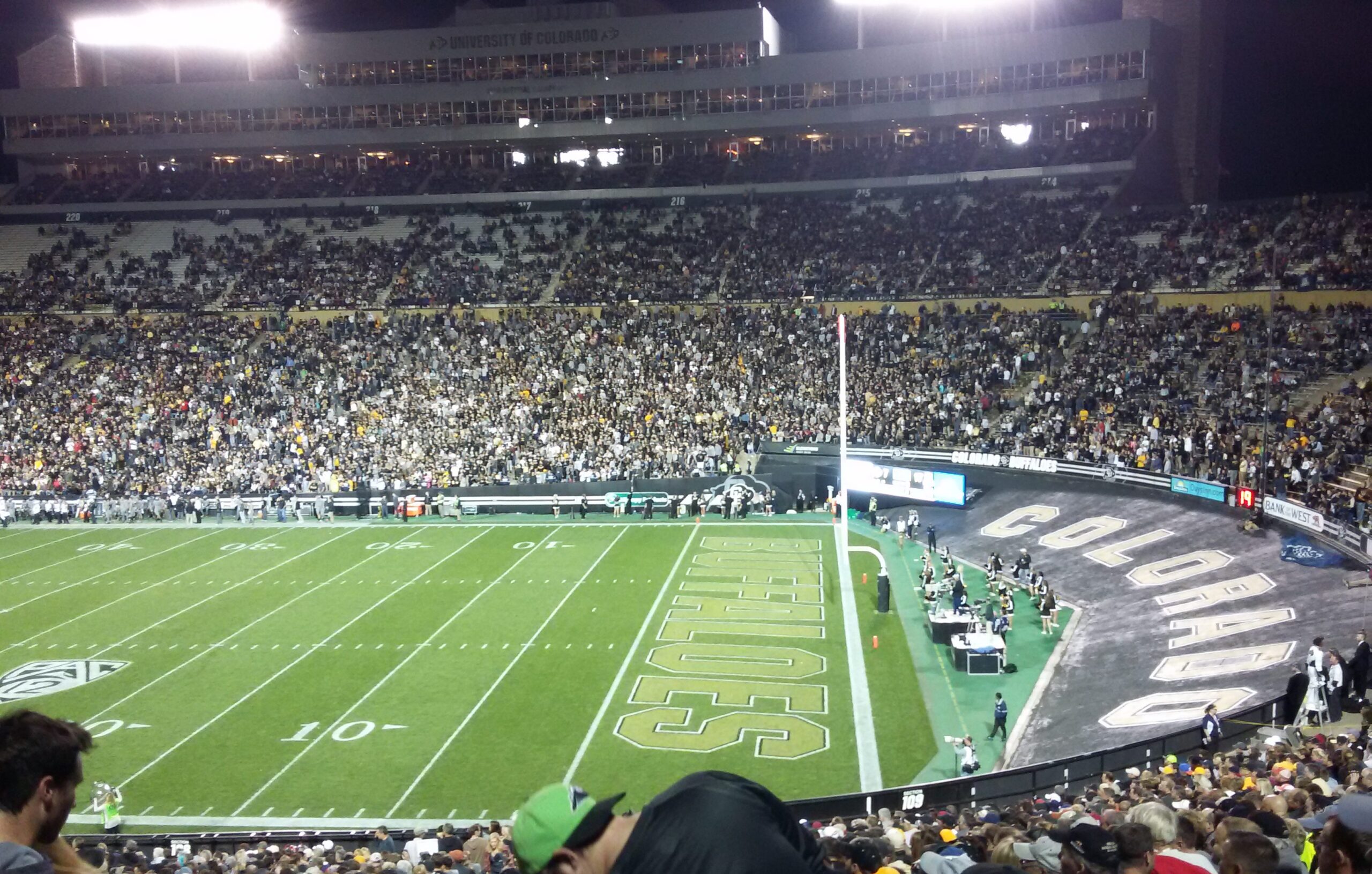
While the students weren’t leaving as early as in years past, they were still arriving late, and there were barely enough students at the USC game before kickoff to pull off our rescheduled card stunt, which did make it on the ESPN2 broadcast. It was a big step up from the previous year, but we knew we could do better. It was like pulling teeth trying to get the students to cooperate with it. We were so worried that the cards would become projectiles that we had to go through and collect them afterward, which involved me acting like a cop and ripping half-completed paper airplanes out of the hands of a few drunk students, who proceeded to tell me exactly where I could go.
And there is the card stunt. Solid work @folsomfrenzy pic.twitter.com/kVJIXrbwMc
— Andrew G. Haubner (@A_G_Haubner) November 14, 2015
Speaking of projectiles…
One of the more interesting things that happened during the 2015 season was the reintroduction of some controlled chaos into the student section. CU fans have never exactly been known for their good behavior, and some people (not necessarily affiliated with Folsom Frenzy) decided they wanted to bring back some of that image. During three different games, a “rogue squadron,” some of whom I knew and some of whom I did not know, snuck items into the stadium. For the Oregon game, it was yellow rubber duckies that were placed in the urinals in the men’s bathrooms in the stadium. During the Arizona game, marshmallows were smuggled into Folsom in an attempt to stage the first marshmallow fight in over a decade. More people threw them onto the field than at each other. Finally, during the USC game, which was a blackout, white baby powder was unleashed on an unsuspecting populace. It was a cool visual, but the smell wasn’t worth it.
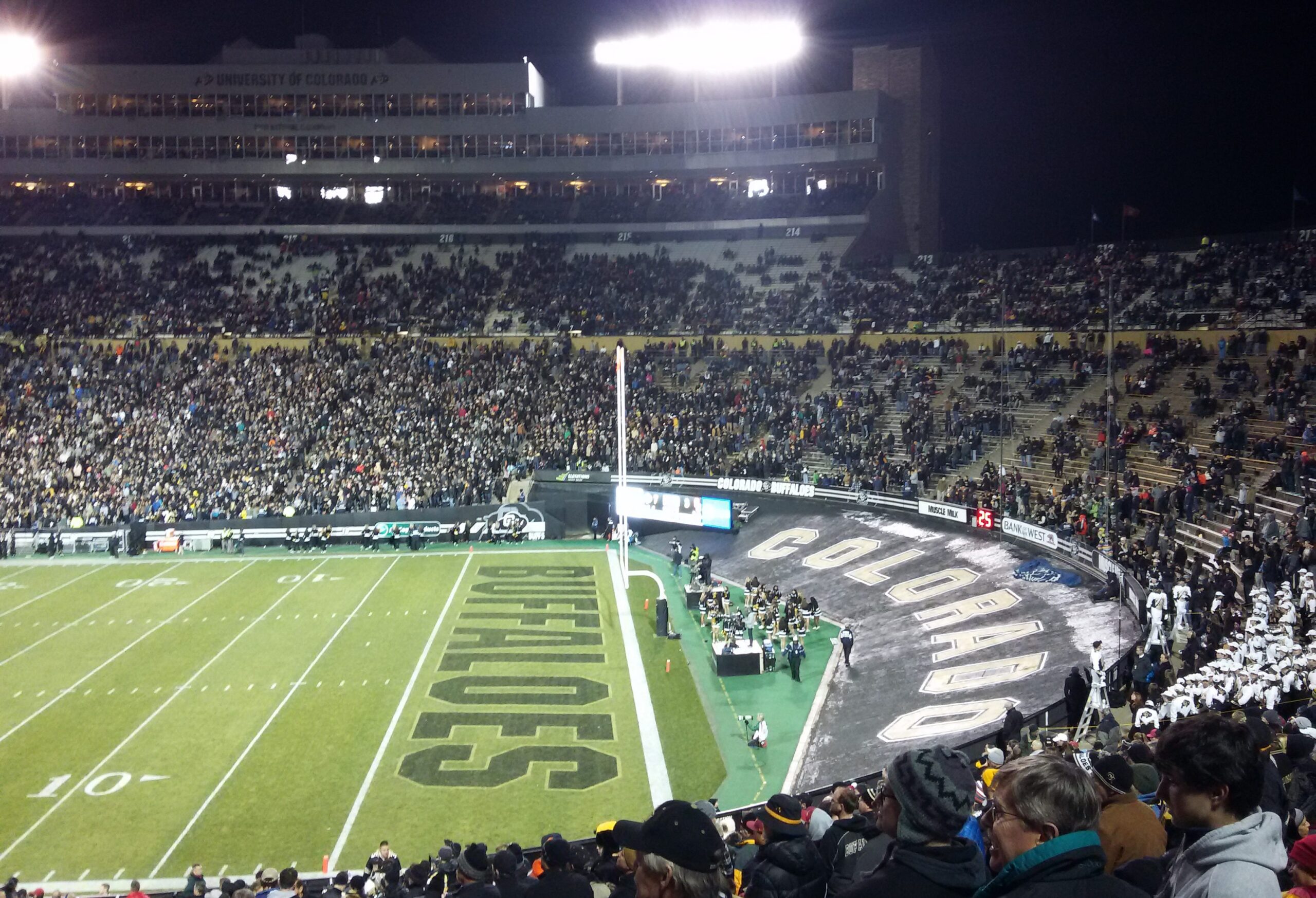
2015 was almost as demoralizing a season as 2014 had been, and yet there had been undeniable strides in the student section. Fans were arriving earlier, staying later, and showing up in greater numbers. Overall there was a five percent increase in CU’s attendance between 2014 and 2015, but student attendance rose 31 percent. For the first time since 2011, there were no games with the dubious distinction of having less than 1000 student attendees, although, in fairness, there were no games over Thanksgiving break in 2015.
Still, the breakthrough eluded us.
Part Four (2016)
Entering 2016, there were plenty reasons to be optimistic about Colorado Football. The Buffs were one of the most experienced teams in the entire country, and the hashtag “#TheRise” had started to float around in fall camp as people inside the program started to sense that this team might be different.
There were reasons for optimism about the student section as well. In May of 2016, the decision was reached that all of the CU student sections would now be known as the C-Unit. This is something that probably should have been done before the founding of Folsom Frenzy, but it’s a good thing that it happened at all. Each section retained its original (now renamed) Twitter account and followers, as well as their own internal structures and executive boards, but there would now be a single coherent branding that everyone could identify with.
I was lucky enough to get some input on the final logo design (the “Est. 2004” and the “UNIT” being placed on the stripe instead of “Boulder, CO” were my main contributions. I wanted them to make the C the same as the Colorado state flag, but they didn’t go for it.) With the new branding and marketing push behind that, our Twitter and Instagram numbers started to increase at a faster pace, and it was around this time that I was named the head of social media for C-Unit Football, as we were now known.
ATTENTION BUFF NATION!
We have re-branded with a new name and logo! pic.twitter.com/AgMtpKoizk
— C-Unit (@CUnitBuffs) August 26, 2016
Marketing also did something we had begged them to do two years prior; they cut the price of the sports pass from $175 to $99. Suddenly, it didn’t feel like we had to twist the arms of the freshmen to buy it anymore. Before the season opener against CSU, I saw the numbers we were doing on sports pass sales and felt elated. Of course, I was still terrified of a season-opening loss like we’d had the previous two seasons. I was skeptical of all the hype surrounding the team during fall camp because of what I had witnessed over the previous decade: so skeptical that when I bought a shirt that said “#THERISE” at the team store the day before the game, I kept the tag on it just in case.
The 2016 edition of the Rocky Mountain Showdown was glorious and stress-free. The result was never in doubt, and by the end of the first quarter the south stands at Mile High were completely full of black shirts. I had never seen it before, and it was gorgeous. The fact that many left before the end of the game didn’t bother me.
The next week against Idaho State saw the second-largest student section since 2014, and once again the Buffs were winning by so much that they left early. This was a new problem we were happy to have to deal with.
It was obvious that this team was different, but for people to really buy in they would have to finally get that signature win that had eluded them for so many years. For a time it appeared that it might come against No. 4 Michigan, but Sefo Liufau, Derek McCartney, and Diego Gonzalez all went down, and the game became another disappointment.
Then, the Oregon game happened, and a crowd of students welcomed the bus back to the Champions Center. That was the moment that I knew this team had finally won over the student body, and that they would actually get the benefit of the doubt if they lost a game or two.
The next game against Oregon State was a noon kickoff, typically death for any hope of a decent student section. I thought it would be a good idea to do another whiteout in honor of the team’s victory at Oregon in the all-white uniforms, and the fact that they were wearing mostly-white uniforms against OSU.
This time it wasn’t really a coordinated effort between us and university marketing. We did it all via our own social media channels, which were growing more popular by the day as the team continued to attract new fans. The result was not as flawless as the year before, but it still looked pretty cool, especially in the student section. You definitely can’t confuse the crowd shots from that game with any other game in Folsom from the last 10 years, and that’s what I’m pleased with. Oh yeah, as for the student section: we got more than any game since my Freshman year. For a noon kick against a terrible team. The Rise certainly appeared to be real, and CU entering the Top 25 the following week for the first time since 2005 confirmed it.
A difficult loss against USC dropped the Buffs out of the Top 25 before their game against Arizona State, who were 5-1, leading the Pac-12 South, and No. 24 in the coaches poll. The kickoff time was at 6 pm and Oct. 15, 2016, was a gorgeous day in Boulder. Yet, I was still concerned that we might not fill the end zone entirely. I had never seen it done in my three and a half years at CU. Before the 2016 season, the band was moved one section over; shrinking the student section by a full section, and there was still a nearly-empty section for the Idaho State and Oregon State games. Shortly after kickoff, I realized that I needn’t have worried.
It was the largest student section, and the largest crowd overall, to see a game at Folsom Field since 2011. It was a thing of beauty. I told myself that, no matter what happened the rest of the season, at least we had reached this point. The Buffs, who had been annihilated by ASU at home in 2012 (the last time there were even close to as many students at a game in Folsom), and who had seen their comeback bid fall short in front of an empty stadium in 2014, thoroughly trounced the Sun Devils in front of a crowd that (mostly) stayed until the end.
After the game, a small amount of students rushed the field. Now, as ASU was unranked in the AP Top 25 (the only poll CU fans recognize as legitimate) and the Buffs were favored in the game, I was opposed to the idea. But I did it, because I had never gotten the chance in my previous three seasons, and because I thought I might never get to do it again. Little did I know.
The ASU game also saw my final real contribution to the student section come into its own. When I watched the Euro Cup in the summer of 2016, I was blown away by the chant the Icelandic fans did after their team won against England. It gave me chills. I thought just about the only place it could be replicated in America was in a college student section, and I started to talk with other members of the C-Unit to see if it could be done. It took a lot of coordination with the band, as well as the in-stadium TV crew because Folsom had to be totally silent with the exception of one drum and the student section. We debuted the “Iceland clap” at the Idaho State game, and it went ok, but the overall effect was underwhelming, and the timing was off. We did it again against Oregon State, and it went better, but it still wasn’t what I knew it could be. Finally, against Arizona State, it all came together. The student section was full, the game was at night, and we finally got the timing (mostly) right.
We looked good last night 😎
— C-Unit (@CUnitBuffs) October 16, 2016
We only got better at it as the season went on. Against UCLA it prompted the Fox Sports crew to say, “What an atmosphere in Boulder!” Against Utah, it was so loud that players on the Utah sideline on the opposite side of the field turned around to watch. It is my sincere hope that future leaders of the C-Unit keep this tradition going, because it’s one of the coolest things I’ve seen in any college student section. I know CU wasn’t the only school to do it last year, but I can’t think of anyone who did it better.
The blackout game in 2016 was against UCLA, and we had another card stunt planned. This time it would cover an entire section with over 1500 cards. After some debate, we decided that the cards would read “THE RISE.” By this point, the Buffs had already clinched a bowl bid, and they were about to enter the top 25 again after knocking off Stanford on the road. There was no longer any question about whether or not the Rise was real.
I remember sitting around working on making cards with the rest of the C-Unit exec board while watching the first College Football Playoff rankings show. We could hardly believe it when CU came in at No. 15. This was all too good to be true.
The day of the UCLA game was warm and beautiful. By kickoff, there were already three full sections of students, and the back of the end zone was full by the end of the first quarter. If the Arizona State game was a full student section, UCLA was packed.
At the beginning of the second quarter, after the loudest Iceland clap yet, we did the card stunt. This time people were excited to participate in it. The result looked awesome and got a huge ovation from the stadium. That sequence, which got featured on the FS1 broadcast, was the moment where I felt like we had finally arrived as a student section.
#theRISEisREAL pic.twitter.com/1GqoWEhu9N
— Pac-12 Network (@Pac12Network) November 4, 2016
It was an ugly game, but it was close, and the student section was still completely full near the end of the fourth quarter, when Isaiah Oliver took a punt back to the house to seal the game for CU. The student section was a madhouse. I almost fell over from all the pushing and shoving, and I was standing on solid ground to begin with. As the students filed out after the game, I was happy, but also I felt like the fact that the last two games being over Thanksgiving break would kill any chances of there being another atmosphere like the UCLA game. Once again, I was wrong.
Before the Washington State game, the first top-25 matchup at Folsom Field since 2002, I was terrified that the student section would look awful. This was the first network television game at Folsom since 2009, and I thought we were going to get roasted on social media. I even told the Sports Illustrated photographer who was there for the game not to take any pictures facing the end zone. As it turned out, I shouldn’t have worried.
While it wasn’t up to the numbers we did for Arizona State or UCLA, it looked just fine on TV. Unless you were really scrutinizing it, the end zone looked full. After the game, CU’s first victory over a ranked opponent in eight years, there was another field rush. This time I declined to participate, because I knew there would be another one a week later.
Yeah, I was that confident. Earlier in the year, I would never have expected CU to beat anyone. I was even nervous heading into the Oregon State game. But now I felt like there was no way the Buffs could lose on Senior Day with the Pac-12 South on the line. I wasn’t even worried about the student section, despite the fact that the game was on the last Saturday of Thanksgiving break.
This was the fullest I’d ever seen the student section at kickoff, including the Hawkins years. Overall, it was the most over-capacity crowd Folsom had seen since 2002 (the overall attendance records set during the post-club level, pre-Champions Center era will likely never be challenged). The number of student scans at the gate was slightly below the UCLA game, but it was still over a thousand more than any other game since 2011. And it was 16-times the size of the student sections the last two times CU had played Utah on the final Saturday of November. The phrase “if you build it, they will come” never seemed more apropos.
I’ll never forget what it was like when Kenneth Olugbode scooped up the fumble and ran into the end zone right in front of the student section in the fourth quarter. I think I may have punched a few people out of sheer joy. After the game, the students weren’t the only ones who made their way down to the field to celebrate one of the most improbable division titles in major college football history.
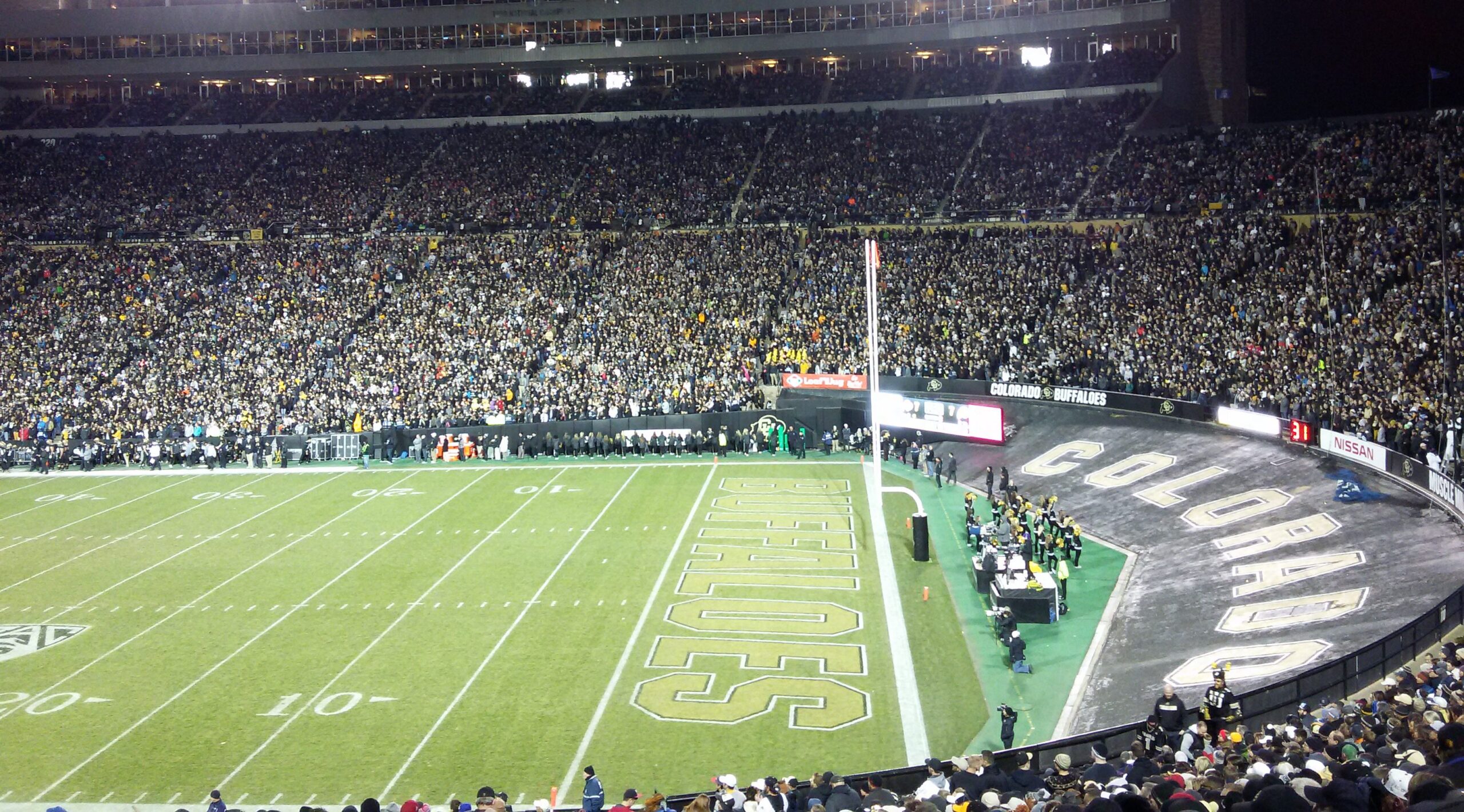
As I walked around the field after my last game as a student, not wanting to ever leave, I reflected back on all the hard work, heartache and disappointments from my first few years and asked myself if it was all worth it. The answer was yes.
Epilogue (2017 and beyond)
Current CU sophomores have never attended a home loss. Let that sink in. Now, try to imagine the kind of impact that’s going to have going forward. What’s more, they know what the C-Unit is, they remember the Iceland clap, they remember the card stunt, and they remember how much fun they had last year. Some of them will be doing what I used to do in the years to come. But they probably won’t have to beg students to come to games anymore.
Imagine you’re an incoming freshman at CU this fall. The Buffs are undeniably cool again. All the stories you’ve heard from your older friends have been about blowing out CSU, rushing the field against Utah and waiting for the team bus to get back from the airport after the Oregon Game. Compare that to the tales of humiliation and leaving before halftime that my freshman class was treated to.
College football is cyclical, and the Buffs will have difficult seasons again, but I’m hopeful that there is now enough of an established student section culture and leadership to prevent things from getting as bad as they were a few years ago. Overall attendance dropped about 25 percent between 2011 and 2014. Student attendance more than halved. But in 2016, overall attendance rose 18 percent from 2015, and student attendance was up 85 percent.
Student attendance is far more volatile than the general public, and each year presents new challenges. Their loyalty is not as strong as the average adult alum who has spent a lifetime supporting the team, and they can leave just as quickly as they show up. That said, C-Unit finally has its feet under it now. Marketing also finally has some money to play with, and Saturday will see the debut of something really exciting in the student section. It’s the kind of thing we asked for so many times back in 2014/15, only to be told there wasn’t enough money. Now there is. Heck, they might even get t-shirts this year.
So I’ve just spilled 7,000 words about this subject, and it might sound like I’m giving the C-Unit/Folsom Frenzy/myself too much credit for student attendance coming back. Maybe I am. The games at the end of last year would probably have been packed even if we had never existed. But when I look at the progression of photographs from 2014 to the beginning of 2016, before people knew the Rise was real, I see a real change despite the team going 6-19 (1-17) and failing to win a single home conference game during that stretch. And getting students to the game was only ever part of the purpose of Folsom Frenzy/C-Unit. It was about getting them there earlier, having them stay later, and trying to make it more fun while they were there so that they would come back regardless of the result of the game.
You can make up your own mind, but I believe it took a combination of the team incrementally improving and a small group of students working their tails off to try and get people to the games. There was a time when the football program was a punchline around campus, and when it was definitely uncool to be passionate about them. When it seemed like no one at the whole university cared, I discovered a group who did. Even if the dream season of 2016 had never happened, I would sleep just fine at night knowing that I did everything I could to help the football program I have always loved so much.
These people can say the same. It’s an incomplete list, but these are the people I worked the most with during my three years on the executive board.
Jacob Pauly (founder, first president), Jake Shapiro (first VP), Taylor Thomas (second president), Sreyas Krishnan, Chase Youngman (third president), Grant Vanek, Scott Morton, Bryce Mawhiney, Davis Rahjes, Brent Nelle (second VP), Emily Thomas, Katie Kritzmire, Jack Perkins, Eric Murphy, Chris Melendez, David Burch
Comments
Share your thoughts
Join the conversation




